Colon Transit Time Test in Korean Children with Chronic Functional Constipation
- Affiliations
-
- 1Department of Pediatrics, Konkuk University School of Medicine, Seoul, Korea. baedori@hanafos.com
- KMID: 2160474
- DOI: http://doi.org/10.5223/pghn.2016.19.1.38
Abstract
- PURPOSE
Each ethnic group has a unique life style, including diets. Life style affects bowel movement. The aim of this study is to describe the results of colon transit time (CTT) tests in Korean children who had chronic functional constipation based on highly refined data.
METHODS
One hundred ninety (86 males) out of 415 children who performed a CTT test under the diagnosis of chronic constipation according to Rome III criteria at Konkuk University Medical Center from January 2006 through March 2015 were enrolled in this study. Two hundreds twenty-five children were excluded on the basis of CTT test result, defecation diary, and clinical setting. Shapiro-Wilk and Mann-Whitney U, and chi-square tests were used for statistical analysis.
RESULTS
The median value and interquartile range (IQR) of CTT was 54 (37.5) hours in Encopresis group, and those in non-encopresis group was 40.2 (27.9) hours (p<0.001). The frequency of subtype between non-encopresis group and encopresis was statistically significant (p=0.002). The non-encopresis group (n=154, 81.1%) was divided into normal transit subgroup (n=84, 54.5%; median value and IQR of CTT=26.4 [9.6] hours), outlet obstruction subgroup (n=18, 11.7%; 62.4 [15.6] hours), and slow transit subgroup (n=52, 33.8%; 54.6 [21.0] hours]. The encopresis group (n=36, 18.9%) was divided into normal transit subgroup (n=8, 22.2%; median value and IQR of CTT=32.4 [9.9] hours), outlet obstruction subgroup (n=8, 22.2%; 67.8 [34.8] hours), and slow transit subgroup (n=20, 55.6%; 59.4 [62.7]hours).
CONCLUSION
This study provided the basic pattern and value of the CTT test in Korean children with chronic constipation.
Keyword
MeSH Terms
Figure
Cited by 3 articles
-
Correlation between Colon Transit Time Test Value and Initial Maintenance Dose of Laxative in Children with Chronic Functional Constipation
Mock Ryeon Kim, Hye Won Park, Jae Sung Son, Ran Lee, Sun Hwan Bae
Pediatr Gastroenterol Hepatol Nutr. 2016;19(3):186-192. doi: 10.5223/pghn.2016.19.3.186.Efficacy and Safety of Combined Oral and Enema Therapy Using Polyethylene Glycol 3350-Electrolyte for Disimpaction in Pediatric Constipation
Taeyeon Yoo, Sun Hwan Bae
Pediatr Gastroenterol Hepatol Nutr. 2017;20(4):244-251. doi: 10.5223/pghn.2017.20.4.244.Clinical Features of Severely Constipated Children: Comparison of Infrequent Bowel Movement and Fecal Soiling Groups
Gyung Lee, Jae Sung Son, Sun Hwan Bae
Pediatr Gastroenterol Hepatol Nutr. 2020;23(1):26-34. doi: 10.5223/pghn.2020.23.1.26.
Reference
-
1. Lee OY. Asian motility studies in irritable bowel syndrome. J Neurogastroenterol Motil. 2010; 16:120–130.
Article2. Jung HK, Kim DY, Moon IH. Effects of gender and menstrual cycle on colonic transit time in healthy subjects. Korean J Intern Med. 2003; 18:181–186.
Article3. Lembo AJ, Ullman SP. Constipation. In : Feldman M, Friedman LS, Brandt LJ, editors. Sleisenger and Fordtran's gastrointestinal and liver disease. 9th ed. Philadelphia: Saunders Elservier Co.;2010. p. 259–284.4. Arhan P, Devroede G, Jehannin B, Lanza M, Faverdin C, Dornic C, et al. Segmental colonic transit time. Dis Colon Rectum. 1981; 24:625–629.
Article5. Gutiérrez C, Marco A, Nogales A, Tebar R. Total and segmental colonic transit time and anorectal manometry in children with chronic idiopathic constipation. J Pediatr Gastroenterol Nutr. 2002; 35:31–38.
Article6. Bautista Casasnovas A, Varela Cives R, Villanueva Jeremias A, Castro-Gago M, Cadranel S, Tojo Sierra R. Measurement of colonic transit time in children. J Pediatr Gastroenterol Nutr. 1991; 13:42–45.
Article7. Corazziari E, Cucchiara S, Staiano A, Romaniello G, Tamburrini O, Torsoli A, et al. Gastrointestinal transit time, frequency of defecation, and anorectal manometry in healthy and constipated children. J Pediatr. 1985; 106:379–382.
Article8. Velde SV, Notebaert A, Meersschaut V, Herregods N, Van Winckel M, Van Biervliet S. Colon transit time in healthy children and adolescents. Int J Colorectal Dis. 2013; 28:1721–1724.
Article9. Choi JE, Choi IJ, Lee JA, Kim SM, Jeong JH, Lee JH. Colonic transit time in chronic constipated patients. J Korean Pediatr Soc. 2001; 44:752–757.10. Lee YJ, Chung KS. The correlation of verbal expression of stool, bristol stool form scale and colon transit time for children with gastrointestinal symptoms. Korean J Pediatr Gastroenterol Nutr. 2005; 8:130–136.
Article11. Kim JW, Chung KS. Colonic transit time in children with recurrent abdominal pain. J Korean Pediatr Soc. 1997; 40:1544–1551.12. Hyman PE, Milla PJ, Benninga MA, Davidson GP, Fleisher DF, Taminiau J. Childhood functional gastrointestinal disorders: neonate/toddler. Gastroenterology. 2006; 130:1519–1526.
Article13. Rasquin A, Di Lorenzo C, Forbes D, Guiraldes E, Hyams JS, Staiano A, et al. Childhood functional gastrointestinal disorders: child/adolescent. Gastroenterology. 2006; 130:1527–1537.
Article14. Metcalf AM, Phillips SF, Zinsmeister AR, MacCarty RL, Beart RW, Wolff BG. Simplified assessment of segmental colonic transit. Gastroenterology. 1987; 92:40–47.
Article15. Papadopoulou A, Clayden GS, Booth IW. The clinical value of solid marker transit studies in childhood constipation and soiling. Eur J Pediatr. 1994; 153:560–564.
Article16. Southwell BR, Clarke MC, Sutcliffe J, Hutson JM. Colonic transit studies: normal values for adults and children with comparison of radiological and scintigraphic methods. Pediatr Surg Int. 2009; 25:559–572.
Article17. de Lorijn F, van Wijk MP, Reitsma JB, van Ginkel R, Taminiau JA, Benninga MA. Prognosis of constipation: clinical factors and colonic transit time. Arch Dis Child. 2004; 89:723–727.
Article18. Tabbers MM, DiLorenzo C, Berger MY, Faure C, Langendam MW, Nurko S, et al. European Society for Pediatric Gastroenterology, Hepatology, and Nutrition. North American Society for Pediatric Gastroenterology. Evaluation and treatment of functional constipation in infants and children: evidence-based recommendations from ESPGHAN and NASPGHAN. J Pediatr Gastroenterol Nutr. 2014; 58:258–274.
Article
- Full Text Links
- Actions
-
Cited
- CITED
-
- Close
- Share
- Similar articles
-
- Colonic Transit Time in Chronic Constipated Patients
- How to Interpret a Functional or Motility Test: Colon Transit Study
- Relevance of Colonic Gas Analysis and Transit Study in Patients With Chronic Constipation
- Classification and Treatment of Constipation
- Clinical Significance of Colon Transit Time Study in Patients with Chronic Constipation



